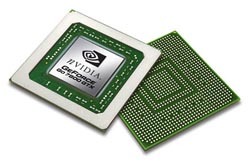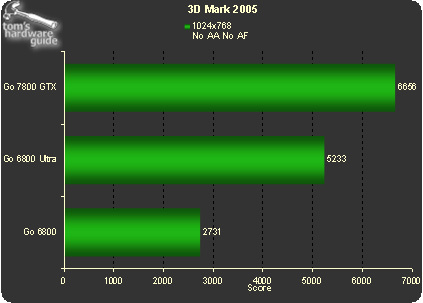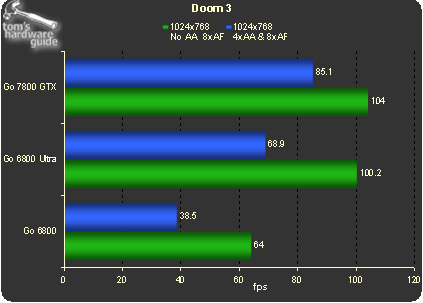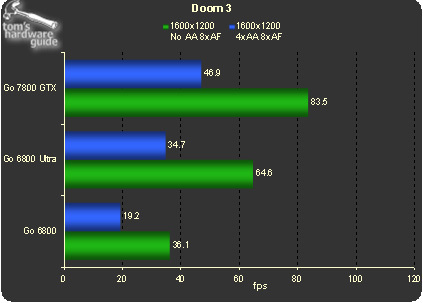Nvidia increases the pace in high-performance mobile graphics
Santa Clara (CA) - Today there is a new face in the high performance mobile graphics market as nVidia launched a new flagship mobile graphics processor, the GeForce Go 7800 GTX. Unlike the launch of the Go 6800 Ultra where Dell had exclusivity at the launch, the Go 7800 GTX will debut in systems from a wide range of OEMs worldwide just about three months after the launch of the desktop chip.
As the name of the new mobile chip indicates, it is a version of the desktop-aimed GeForce 7800 GTX that was launched back in June of this year. As its sibling, the mobile part carries 302 million transistors and runs at a clock speed of 400 MHz, which is 30 MHz below the rate of the 7800 GTX and 50 MHz below the clock speed of the outgoing Go 6800 Ultra. The integrated GGR3 memory is clocked at 550 MHz.
nVidia's latest graphic chip is yet another sign that the company continues to extend its reach into the mobile space and tighten its grip on the graphics market. With the Go 6800 series, the company aimed at the high-end segment of the mobile market and continues to do so with the launch of the Go 7800 GTX. Jerry Chen, senior product manager of the mobile graphics division of Nvidia, told Tom's Hardware Guide that the company sees further growth opportunities for discrete graphics chips for notebooks.
Accordingly, Nvidia plans to extend the Go 7 series down the road with models that are positioned below the 7800 GTX. Chen believes that not just games, but rather multimedia applications and especially the more graphics focused Windows Vista operating system will drive the demand for faster mobile graphics. While he declined to comment on possible integrated graphics (IGP) solutions for notebooks, he said that such lower priced mainstream mobile graphics solutions "make sense" for Nvidia. If brought to market, such IGPs would be "Vista ready," Chen said.
The days of paper launches appear to be history, as Nvidia told us that also the Go 7800 GTX will be available in a number of notebooks today. In the United States, the company promised desktop replacement (DTR) notebooks from OEMs such as ABS and Falcon North West, while north of the border there will be solutions from EuroCom and Voodoo PC. To round out the rest of the world, Dell will use the chip to promote its next generation XPS gaming notebook, the M170 and Alienware will incorporate it into its M-7700 model.
Nvidia said it will be shifting gears with its mobile driver support in the same manner that ATI had done earlier this year with Mobile Catalyst. Instead of letting the OEM's control what driver updates they will support, the company negotiated all future contracts where it will support the mobile hardware with drivers available at nvidia.com. In the past, OEM's have limited the number of driver updates because they would rather have a few that they can manage better. Each time a new driver is released, they have to do due diligence to make sure there are no issues between the new and existing drivers. It is far easier for vendors to limit the update in order to maintain stability. However, the consumer is the one that loses out in the proposition every time, when graphics chip manufacturers issue patches and new driver versions.
We were invited to the nVidia offices last week to see their new mobile hardware in action. During briefings we were able to see some of the titles developed with the help of nVidia hardware and engineers doing what they do best... helping our games look and play better. A few of these new titles that should hit the shelves in time for Christmas include Age of Empires III, Call of Duty 2, Quake 4, F.E.A.R., and Starship Troopers.
Get Tom's Hardware's best news and in-depth reviews, straight to your inbox.
We were also able to sample what consumers can expect from the Dell XPS M170. From what we have seen and tested, the performance of the system is impressive. From the short tests we have been able to perform on the pre-release hardware, the X170 was able to generate a score of 6656 in 3DMark 2005.
In Doom 3 with the image quality set to "High" (NoAA 8xAF) it posted scores of 104 frames per second (fps) at 1024x768 and 83.5 fps at 1600x1200. When we turned on Anti-Aliasing to 4x, it posted 85.1fps at 1024x768 and 46.9fps at 1600x1200.
As with the Go 6800 Ultra, once again we are impressed by the first test results of the chip. The Go 7800 GTX pushes mobile graphics deep into the performance desktop segment and enables gamers to play high resolution and high detailed games at extremely playable frame rates. Equally impressive is the time-to-market of the mobile chip: It used to take a year to a year and a half to see the desktop version reach the mobile segment, now we are down to slightly more than 3 months.
Related stories:
Nvidia GeForce 7800 GTX hits store shelves, really



